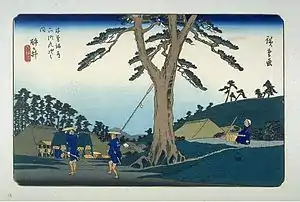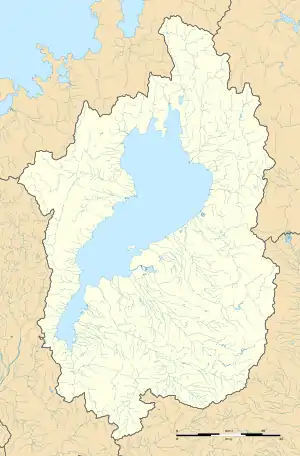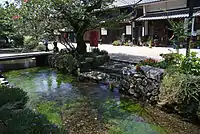Samegai-juku 醒井宿 | |
|---|---|
| post station | |
 Hiroshige's print of Samegai-juku, part of the Sixty-nine Stations of the Kiso Kaidō series | |
| General information | |
| Location | Maibara, Shiga (former Ōmi Province) Japan |
| Coordinates | 35°19′44.4″N 136°21′03.9″E / 35.329000°N 136.351083°E |
| Elevation | 120 meters |
| Line(s) | Nakasendō |
| Distance | 457 kilometers from Edo |
| Location | |
 Samegai-juku Location within Shiga Prefecture  Samegai-juku Samegai-juku (Japan) | |

Samegai-juku (醒井宿, Samegai-juku) was the sixty-first of the sixty-nine stations of the Nakasendō highway connecting Edo with Kyoto in Edo period Japan. It was located in the present-day city of Maibara, Shiga Prefecture, Japan.
History
Samegai-juku has a very long history, and was mentioned by name in the Nihon Shoki, which was completed in 720 AD, and in the even earlier Kojiki chronicle in connection with the Yamato Takeru mythology. It was located on the ancient Tōsandō highway connecting the capital of Heian-kyō with the provinces of eastern Japan, and continued to be mentioned in the diaries and the poems of travelers in the Heian and Kamakura periods. One of the main attractions of this station was the fresh and clear waters from the nearby Jizogawa river and many travelers thought of Samegai as a proper resting place.[1]
In the early Edo period, the system of post stations on the Nakasendō was formalized by the Tokugawa shogunate in 1602, and it was a stopping place for traveling merchants (Ōmi shōnin (近江商人)) who originated from Ōmi Province. It was on the sankin-kōtai route by various western daimyō to-and-from the Shogun's court in Edo. The station was also a transportation hub, as the Jizogawa river was navigable by small boats and barges, and was used to carry goods. Samegai-juku had seven warehouses (Tonyaba) lining its banks, far more than most other stations.
Per the 1843 "中山道宿村大概帳" (Nakasendō Shukuson Taigaichō) guidebook issued by the Inspector of Highways (道中奉行, Dōchu-būgyō), the town had a population of 539 people in 138 houses, including one honjin, one waki-honjin, and 11 hatago.
Modern Samegai-juku
There are still ten buildings remaining from the Edo period today, giving visitors an idea of how the town looked hundreds of years ago.[2] There is also an archives museum located in a Meiji period former post office which gives greater detail to the post town's past.
Samegai-juku in The Sixty-nine Stations of the Kiso Kaidō
Utagawa Hiroshige's ukiyo-e print of Samegai-juku dates from 1835 -1838. The print is dominated by a large pine tree in the center of the composition, with the thatched roofs of several buildings in the background. These buildings are the famous Rokken jaya of Samegai-juku, six hatago built for the purposes of housing the retinues which accompanied daimyō processions (while the lord himself stayed at the honjin). Two samurai retainers, one bearing a long spear, approach the buildings, while on the slope behind, four more have loads on their shoulders. The scene is observed by a seated farmer smoking a pipe, with the Hira Mountains in the background, beyond which is Lake Biwa.
Gallery
 old building in Samegai-juku
old building in Samegai-juku Panorama of Samegai-juku
Panorama of Samegai-juku Jizogawa
Jizogawa Kamo Jinja
Kamo Jinja_2012.8.26_-_panoramio.jpg.webp) former Samegai Post Office, now a museum
former Samegai Post Office, now a museum Museum of Woodcarving in Samegai
Museum of Woodcarving in Samegai
Neighboring post towns
- Nakasendō
- Kashiwabara-juku - Samegai-juku - Banba-juku
Notes
- ↑ Machinami Kaidō Samegai-juku. Accessed July 23, 2007.
- ↑ Samegai-juku Kankō & Rējā Gaido Archived 2006-06-28 at the Wayback Machine. Shobunka Publications, Inc. Accessed July 23, 2007.
References
- Izzard, Sebastian (2008). The Sixty-Nine Stations of the Kisokaido. George Braziller. ISBN 0807615935.
- Berna, Cristina (2019). Hiroshige 69 Stations of the Nakasendō. Missys Clan. ISBN 2919787667.
- Kishimoto, Yutaka (2016). 中山道浪漫の旅 書き込み手帖. Shinano Mainichi Shimbun. ISBN 4784072977. (in Japanese)
- Yagi, Makio (2014). ちゃんと歩ける中山道六十九次 西 藪原宿~京三条大橋. 山と渓谷社. ISBN 4635600785. (in Japanese)